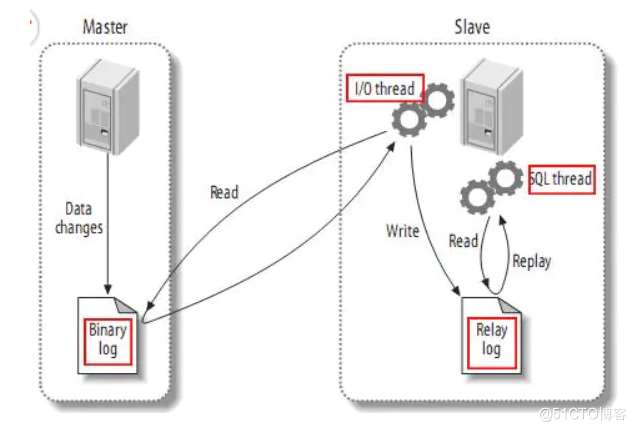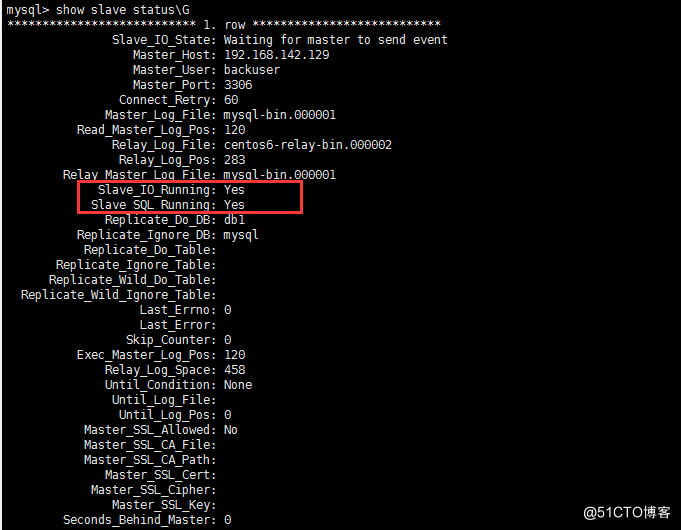系統:centos6.6
主:192.168.142.129 mysql-5.6.30.tar.gz
從:192.168.142.130 192.168.142.131 mysql-5.6.30.tar.gz
一、mysql主從復制原理

(1) master將改變記錄到二進制日志(binary log)中;
(2) slave將master的binary log events拷貝到它的中繼日志(relay log);slave的i/o線程從master的二進制日志中讀取事件并寫入中繼日志;
(3) slave重做中繼日志中的事件,將改變反映它自己的數據。slave的sql線程從中繼日志讀取事件,并在本地重放其中的事件,使其與master中的數據一致。
mysql主從實現的步驟:
1、使用mysqldump 命令備份數據庫,
2、查看主節點二進制的位置點
3、創建備份用戶,并授權(replication client.replication slave)
4、從服務器修改server-id,必須與主mysql的server-id不同,開啟中繼日子,關閉二進制日子
5、從數據庫,倒入數據,并使用授權用戶,連接主mysql
6、start slave
sql語言共分為以下幾大類:查詢語言dql,控制語言dcl,操縱語言dml,定義語言ddl。事務控制tcl.
dql(data query languages)語句:即數據庫定義語句,用來查詢select子句,from子句,where子句組成的查詢塊,比如:select–from–where–grouop by–having–order by–limit
ddl(data definition languages)語句:即數據庫定義語句,用來創建數據庫中的表、索引、視圖、存儲過程、觸發器等,常用的語句關鍵字有create,alter,drop,truncate,comment,rename。增刪改表的結構
dml(data manipulation language)語句:即數據操縱語句,用來查詢、添加、更新、刪除等,常用的語句關鍵字有:select,insert,update,delete,merge,call,explain plan,lock table,包括通用性的增刪改查。增刪改表的數據
dcl(data control language)語句:即數據控制語句,用于授權/撤銷數據庫及其字段的權限(dcl is short name of data control language which includes commands such as grant and mostly concerned with rights, permissions and other controls of the database system.)。常用的語句關鍵字有:grant,revoke。
tcl(transaction control language)語句:事務控制語句,用于控制事務,常用的語句關鍵字有:commit,rollback,savepoint,set transaction。
二、mysql編譯安裝
|
1
2
3
4
5
6
7
8
9
10
11
12
13
14
15
16
17
18
19
20
21
22
23
24
25
26
27
28
29
30
31
32
33
34
35
36
37
38
39
40
41
42
43
44
45
46
47
48
49
50
51
52
53
54
55
56
57
58
59
60
61
62
63
64
65
66
67
68
69
70
71
72
73
74
75
76
77
78
79
80
81
82
83
84
85
86
87
88
89
90
91
92
93
94
95
96
97
98
99
100
101
102
103
104
105
106
107
108
109
110
111
112
113
114
115
116
117
118
119
120
121
122
123
124
125
126
127
128
129
130
131
132
133
134
135
136
137
138
139
140
141
142
143
144
145
146
147
148
149
150
151
152
153
154
155
156
157
158
159
160
161
162
163
164
165
166
167
168
169
170
171
172
173
174
175
176
177
178
179
180
181
182
183
184
185
186
187
188
189
190
191
192
193
194
195
196
197
198
199
200
201
202
203
204
205
206
207
208
209
210
211
212
213
214
215
216
217
218
219
220
221
222
223
224
225
226
227
228
229
230
231
232
233
234
235
236
237
238
239
240
241
242
243
244
245
246
247
248
249
250
251
252
253
254
255
256
257
258
259
260
261
262
263
264
265
266
267
268
269
270
271
272
273
274
275
276
277
278
279
280
281
282
283
284
285
286
287
288
289
290
291
292
293
294
295
296
297
298
299
300
301
302
303
304
305
306
307
308
309
310
311
312
313
314
315
316
317
318
319
320
321
322
323
324
325
326
327
328
329
330
331
332
333
334
335
336
337
338
339
340
341
342
343
344
345
346
347
348
349
350
351
352
353
354
355
356
357
358
359
360
361
362
363
364
365
366
367
368
369
370
371
372
373
374
375
376
377
378
379
380
381
382
383
384
385
386
387
388
389
390
391
392
393
394
395
396
397
398
399
400
401
402
403
404
405
406
407
408
409
410
411
412
413
414
415
416
417
418
419
420
421
422
423
424
425
426
427
428
429
430
431
432
433
434
435
436
437
438
439
440
441
442
443
444
445
446
447
448
449
450
451
452
453
454
455
456
457
458
459
460
461
462
463
464
465
466
467
468
469
470
471
472
473
474
475
476
477
478
479
480
481
482
483
484
485
486
487
488
489
490
491
492
493
494
495
496
497
498
499
500
501
502
503
504
505
506
507
508
509
510
511
|
#!/bin/bashyum -y install make gcc gcc-c++ openssl openssl-devel pcre-devel gd cmake ncurses ncurses-develid -u mysqlif [ `echo $?` -ne 0 ];thengroupadd mysqluseradd -m -g mysql -s /sbin/nologin mysqlfiif [ ! -d "/usr/local/mysql" ];then mkdir -p /usr/local/mysqlfimkdir -p /data/mysqlchown -r mysql:mysql /data/mysqlcd /home/soft/ #軟件存放目錄tar zxvf mysql-5.6.30.tar.gzcd mysql-5.6.30cmake -dcmake_install_prefix=/usr/local/mysql -dsysconfdir=/etc -dmysql_datadir=/data/mysql/data -dinstall_mandir=/usr/share/man -dmysql_tcp_port=3306 -dmysql_unix_addr=/tmp/mysql.sock -ddefault_charset=utf8 -dextra_charsets=all -ddefault_collation=utf8_general_ci -dwith_readline=1 -dwith_ssl=system -dwith_embedded_server=1 -denabled_local_infile=1 -dwith_innobase_storage_engine=1make && make installchown -r mysql:mysql .chmod +x scripts/mysql_install_db./scripts/mysql_install_db --user=mysql --basedir=/usr/local/mysql --datadir=/data/mysqlcp ./support-files/mysql.server /etc/rc.d/init.d/mysqldchmod 755 /etc/init.d/mysqldchkconfig mysqld oncat> /etc/rc.d/init.d/mysqld <<'eof' #mysql啟動腳本#!/bin/sh# copyright abandoned 1996 tcx datakonsult ab & monty program kb & detron hb# this file is public domain and comes with no warranty of any kind# mysql daemon start/stop script.# usually this is put in /etc/init.d (at least on machines sysv r4 based# systems) and linked to /etc/rc3.d/s99mysql and /etc/rc0.d/k01mysql.# when this is done the mysql server will be started when the machine is# started and shut down when the systems goes down.# comments to support chkconfig on redhat linux# chkconfig: 2345 64 36# description: a very fast and reliable sql database engine.# comments to support lsb init script conventions### begin init info# provides: mysql# required-start: $local_fs $network $remote_fs# should-start: ypbind nscd ldap ntpd xntpd# required-stop: $local_fs $network $remote_fs# default-start: 2 3 4 5# default-stop: 0 1 6# short-description: start and stop mysql# description: mysql is a very fast and reliable sql database engine.### end init info# if you install mysql on some other places than /usr/local/mysql, then you# have to do one of the following things for this script to work:## - run this script from within the mysql installation directory# - create a /etc/my.cnf file with the following information:# [mysqld]# basedir=<path-to-mysql-installation-directory># - add the above to any other configuration file (for example ~/.my.ini)# and copy my_print_defaults to /usr/bin# - add the path to the mysql-installation-directory to the basedir variable# below.## if you want to affect other mysql variables, you should make your changes# in the /etc/my.cnf, ~/.my.cnf or other mysql configuration files.# if you change base dir, you must also change datadir. these may get# overwritten by settings in the mysql configuration files.basedir=/usr/local/mysqldatadir=/data/mysql# default value, in seconds, afterwhich the script should timeout waiting# for server start. # value here is overriden by value in my.cnf. # 0 means don't wait at all# negative numbers mean to wait indefinitelyservice_startup_timeout=900# lock directory for redhat / suse.lockdir='/var/lock/subsys'lock_file_path="$lockdir/mysql"# the following variables are only set for letting mysql.server find things.# set some defaultsmysqld_pid_file_path=if test -z "$basedir"then basedir=/usr/local/mysql bindir=/usr/local/mysql/bin if test -z "$datadir" then datadir=/data/mysql/data fi sbindir=/usr/local/mysql/bin libexecdir=/usr/local/mysql/binelse bindir="$basedir/bin" if test -z "$datadir" then datadir="$basedir/data" fi sbindir="$basedir/sbin" libexecdir="$basedir/libexec"fi# datadir_set is used to determine if datadir was set (and so should be# *not* set inside of the --basedir= handler.)datadir_set=# use lsb init script functions for printing messages, if possible#lsb_functions="/lib/lsb/init-functions"if test -f $lsb_functions ; then . $lsb_functionselse log_success_msg() { echo " success! $@" } log_failure_msg() { echo " error! $@" }fipath="/sbin:/usr/sbin:/bin:/usr/bin:$basedir/bin"export pathmode=$1 # start or stop[ $# -ge 1 ] && shiftother_args="$*" # uncommon, but needed when called from an rpm upgrade action # expected: "--skip-networking --skip-grant-tables" # they are not checked here, intentionally, as it is the resposibility # of the "spec" file author to give correct arguments only.case `echo "testing\c"`,`echo -n testing` in *c*,-n*) echo_n= echo_c= ;; *c*,*) echo_n=-n echo_c= ;; *) echo_n= echo_c='\c' ;;esacparse_server_arguments() { for arg do case "$arg" in --basedir=*) basedir=`echo "$arg" | sed -e 's/^[^=]*=//'` bindir="$basedir/bin" if test -z "$datadir_set"; then datadir="$basedir/data" fi sbindir="$basedir/sbin" libexecdir="$basedir/libexec" ;; --datadir=*) datadir=`echo "$arg" | sed -e 's/^[^=]*=//'` datadir_set=1 ;; --pid-file=*) mysqld_pid_file_path=`echo "$arg" | sed -e 's/^[^=]*=//'` ;; --service-startup-timeout=*) service_startup_timeout=`echo "$arg" | sed -e 's/^[^=]*=//'` ;; esac done}wait_for_pid () { verb="$1" # created | removed pid="$2" # process id of the program operating on the pid-filepid_file_path="$3" # path to the pid file. i=0 avoid_race_condition="by checking again" while test $i -ne $service_startup_timeout ; do case "$verb" in 'created') # wait for a pid-file to pop into existence. test -s "$pid_file_path" && i='' && break ;; 'removed') # wait for this pid-file to disappear test ! -s "$pid_file_path" && i='' && break ;; *) echo "wait_for_pid () usage: wait_for_pid created|removed pid pid_file_path" exit 1 ;; esac # if server isn't running, then pid-file will never be updated if test -n "$pid"; then if kill -0 "$pid" 2>/dev/null; then : # the server still runs else # the server may have exited between the last pid-file check and now. if test -n "$avoid_race_condition"; then avoid_race_condition="" continue # check again. fi # there's nothing that will affect the file. log_failure_msg "the server quit without updating pid file ($pid_file_path)." return 1 # not waiting any more. fi fi echo $echo_n ".$echo_c" i=`expr $i + 1` sleep 1 done if test -z "$i" ; then log_success_msg return 0 else log_failure_msg return 1 fi}# get arguments from the my.cnf file,# the only group, which is read from now on is [mysqld]if test -x ./bin/my_print_defaultsthen print_defaults="./bin/my_print_defaults"elif test -x $bindir/my_print_defaultsthen print_defaults="$bindir/my_print_defaults"elif test -x $bindir/mysql_print_defaultsthen print_defaults="$bindir/mysql_print_defaults"else # try to find basedir in /etc/my.cnf conf=/etc/my.cnf print_defaults= if test -r $conf then subpat='^[^=]*basedir[^=]*=\(.*\)$' dirs=`sed -e "/$subpat/!d" -e 's//\1/' $conf` for d in $dirs do d=`echo $d | sed -e 's/[ ]//g'` if test -x "$d/bin/my_print_defaults" then print_defaults="$d/bin/my_print_defaults" break fi if test -x "$d/bin/mysql_print_defaults" then print_defaults="$d/bin/mysql_print_defaults" break fi done fi # hope it's in the path ... but i doubt it test -z "$print_defaults" && print_defaults="my_print_defaults"fi## read defaults file from 'basedir'. if there is no defaults file there# check if it's in the old (depricated) place (datadir) and read it from there#extra_args=""if test -r "$basedir/my.cnf"then extra_args="-e $basedir/my.cnf"else if test -r "$datadir/my.cnf" then extra_args="-e $datadir/my.cnf" fifiparse_server_arguments `$print_defaults $extra_args mysqld server mysql_server mysql.server`## set pid file if not given#if test -z "$mysqld_pid_file_path"then mysqld_pid_file_path=$datadir/`hostname`.pidelse case "$mysqld_pid_file_path" in /* ) ;; * ) mysqld_pid_file_path="$datadir/$mysqld_pid_file_path" ;; esacficase "$mode" in 'start') # start daemon # safeguard (relative paths, core dumps..) cd $basedir echo $echo_n "starting mysql" if test -x $bindir/mysqld_safe then # give extra arguments to mysqld with the my.cnf file. this script # may be overwritten at next upgrade. $bindir/mysqld_safe --datadir="$datadir" --pid-file="$mysqld_pid_file_path" $other_args >/dev/null 2>&1 & wait_for_pid created "$!" "$mysqld_pid_file_path"; return_value=$? # make lock for redhat / suse if test -w "$lockdir" then touch "$lock_file_path" fi exit $return_value else log_failure_msg "couldn't find mysql server ($bindir/mysqld_safe)" fi ;; 'stop') # stop daemon. we use a signal here to avoid having to know the # root password. if test -s "$mysqld_pid_file_path" then mysqld_pid=`cat "$mysqld_pid_file_path"` if (kill -0 $mysqld_pid 2>/dev/null) then echo $echo_n "shutting down mysql" kill $mysqld_pid # mysqld should remove the pid file when it exits, so wait for it. wait_for_pid removed "$mysqld_pid" "$mysqld_pid_file_path"; return_value=$? else log_failure_msg "mysql server process #$mysqld_pid is not running!" rm "$mysqld_pid_file_path" fi # delete lock for redhat / suse if test -f "$lock_file_path" then rm -f "$lock_file_path" fi exit $return_value else log_failure_msg "mysql server pid file could not be found!" fi ;; 'restart') # stop the service and regardless of whether it was # running or not, start it again. if $0 stop $other_args; then $0 start $other_args else log_failure_msg "failed to stop running server, so refusing to try to start." exit 1 fi ;; 'reload'|'force-reload') if test -s "$mysqld_pid_file_path" ; then read mysqld_pid < "$mysqld_pid_file_path" kill -hup $mysqld_pid && log_success_msg "reloading service mysql" touch "$mysqld_pid_file_path" else log_failure_msg "mysql pid file could not be found!" exit 1 fi ;; 'status') # first, check to see if pid file exists if test -s "$mysqld_pid_file_path" ; then read mysqld_pid < "$mysqld_pid_file_path" if kill -0 $mysqld_pid 2>/dev/null ; then log_success_msg "mysql running ($mysqld_pid)" exit 0 else log_failure_msg "mysql is not running, but pid file exists" exit 1 fi else # try to find appropriate mysqld process mysqld_pid=`pidof $libexecdir/mysqld` if test -z $mysqld_pid ; then if test -f "$lock_file_path" ; then log_failure_msg "mysql is not running, but lock file ($lock_file_path) exists" exit 2 fi log_failure_msg "mysql is not running" exit 3 else log_failure_msg "mysql is running but pid file could not be found" exit 4 fi fi ;; *) # usage basename=`basename "$0"` echo "usage: $basename {start|stop|restart|reload|force-reload|status} [ mysql server options ]" exit 1 ;; esacexit 0eofcat> /etc/my.cnf <<'eof' #mysql配置文件[client]#password = your_passwordport = 3306socket = /tmp/mysql.sock# here follows entries for some specific programs# the mysql server[mysqld]port = 3306socket = /tmp/mysql.sockskip-external-lockingkey_buffer_size = 384mmax_allowed_packet = 64mtable_open_cache = 512sort_buffer_size = 2mread_buffer_size = 2mread_rnd_buffer_size = 8mmyisam_sort_buffer_size = 64mthread_cache_size = 8query_cache_size = 32m# try number of cpu's*2 for thread_concurrencythread_concurrency = 8basedir = /usr/local/mysqldatadir = /data/mysqlmax_connections = 5000long_query_time = 1slow_query_log = 1slow_query_log_file = /var/log/mysql/slow.log# don't listen on a tcp/ip port at all. this can be a security enhancement,# if all processes that need to connect to mysqld run on the same host.# all interaction with mysqld must be made via unix sockets or named pipes.# note that using this option without enabling named pipes on windows# (via the "enable-named-pipe" option) will render mysqld useless!lower_case_table_names = 1# replication master server (default)# binary logging is required for replication#log-bin=mysql-binskip-name-resolve# required unique id between 1 and 2^32 - 1# defaults to 1 if master-host is not set# but will not function as a master if omitted#server-id = 1# binary logging - not required for slaves, but recommended#log-bin=mysql-bin## binary logging format - mixed recommended #binlog_format=mixed# uncomment the following if you are using innodb tables#innodb_data_home_dir = /data/mysql/data#innodb_data_file_path = ibdata1:2000m;ibdata2:10m:autoextend#innodb_log_group_home_dir = /data/mysql/data# you can set .._buffer_pool_size up to 50 - 80 %# of ram but beware of setting memory usage too highinnodb_buffer_pool_size = 4096m#innodb_additional_mem_pool_size = 20m# set .._log_file_size to 25 % of buffer pool sizeinnodb_log_file_size = 512m#innodb_log_buffer_size = 8minnodb_flush_log_at_trx_commit = 0#innodb_lock_wait_timeout = 50[mysqldump]quickmax_allowed_packet = 64m[mysql]no-auto-rehash# remove the next comment character if you are not familiar with sql#safe-updates[myisamchk]key_buffer_size = 256msort_buffer_size = 256mread_buffer = 2mwrite_buffer = 2m[mysqlhotcopy]interactive-timeouteofln -s /usr/local/mysql/bin/mysqladmin /usr/binln -s /usr/local/mysql/lib/mysql /usr/libln -s /usr/local/mysql/include/mysql /usr/include/mysqlmkdir /var/lib/mysqlln -s /tmp/mysql.sock /var/lib/mysql/mysql.sockecho 'export path=$path:/usr/local/mysql/bin' >> /etc/profilesleep 2source /etc/profileservice mysqld startsleep 5cd /usr/local/mysql/bin && mysqladmin -uroot password 'mysql' #授權root用戶的passwordsource /etc/profile |
三、主從配置
1、這里驗證主庫有數據的情況,然后授權有復制權限的用戶
|
1
2
3
4
5
6
7
|
mysql> create database db1;mysql> use db1mysql> create table t1(id int, name varchar(12));mysql> insert into t1 values(1, 'tom'), (2, 'jerry'), (3, 'jack');mysql> grant replication slave,replication client on *.* to 'backuser'@'192.168.142.130' identified by 'mysqll';mysql> grant replication slave,replication client on *.* to 'backuser'@'192.168.142.131' identified by 'mysql';mysql> flush privileges; |
2、修改各個數據庫的配置文件后重啟數據庫
|
1
2
3
4
5
6
7
8
9
10
11
12
13
14
|
vi /etc/my.cnf #主庫配置文件server-id=1log-bin=mysql-binbinlog-do-db=db1binlog-ignore-db=mysql vi /etc/my.cnf #從庫配置文件server-id=2 #從庫id不能和主庫一樣,其他從庫往后面排log-bin=relay-binreplicate-do-db=db1 #同步db1庫replicate-ignore-db=mysql #不會同步mysql庫read_only #只讀service mysqld restart |
3、主庫鎖表備份,然后文件傳給從庫
|
1
2
3
4
5
6
7
|
mysql> flush tables with read lock; #主庫鎖表防止新的數據寫入mysql> show master status; #查看主庫位置節點新打開一個終端備份:mysqldump -u root -p --default-character-set=utf8 --opt -q -r --skip-lock-tables db1 > /root/db1.sql scp /root/db1.sql root@192.168.142.130:/root scp /root/db1.sql root@192.168.142.130:/root |
4、從庫導入數據,然后change到主庫的節點
|
1
2
3
4
5
6
7
|
mysql -u root -pmysql> create database db1;mysql> use db1mysql> source /root/db1.sqlmysql> change master to master_host='192.168.142.129',master_user='backuser',master_password='mysql',master_log_file='mysql-bin.000001',master_log_pos=120;mysql> start slave;mysql> show slave status\g |

5、主庫解鎖
mysql> unlock tables;
以上配置對主從不同步,重新配置主從同樣適用。
四、主從不同步
1、造成不同步的原因
?網絡的延遲主從兩臺機器的負載不一致max_allowed_packet設置不一致key自增鍵開始的鍵值跟自增步長設置不一致引起的主從不一致?mysql異常宕機情況下,如果未設置sync_binlog=1或者innodb_flush_log_at_trx_commit=1很有可能
出現binlog或者relaylog文件出現損壞,導致主從不一致mysql本身的bug引起的主從不同步版本不一致,特別是高版本是主,低版本為從的情況下,主數據庫上面支持的功能,從數據庫上面不支持該功能
2、解決辦法
(1)忽略錯誤后,繼續同步
該方法適用于主從庫數據相差不大,或者要求數據可以不完全統一的情況,數據要求不嚴格的情況
|
1
|
stop slave; set global sql_slave_skip_counter =1; start slave; show slave status\g |
(2)重新做主從
參考上面配置主庫鎖表重新做主從。
到此這篇關于mysql5.6主從搭建以及不同步問題詳解的文章就介紹到這了,更多相關mysql主從搭建和不同步內容請搜索服務器之家以前的文章或繼續瀏覽下面的相關文章希望大家以后多多支持服務器之家!
原文鏈接:https://blog.51cto.com/qidian510/4735249














